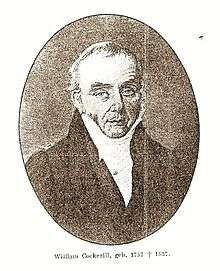William Cockerill
| William Cockerill | |
|---|---|
 | |
| Born |
1759 Lancashire, England |
| Died |
1832 Aachen, Prussia |
| Citizenship |
British after 1810 French (Belgian) |
| Occupation | Inventor, machine maker, industrialist |
William Cockerill (1759–1832) was a British entrepreneur who created a textile machine manufacturing business in Verviers and Liège, Belgium (then part of the French First Republic).
He was instrumental in founding the industrial spinning industry in continental Europe.
Biography
William Cockerill was born in Haslingden, Lancashire, England in 1759.[1] He began his working career as a blacksmith in England, and was said to be exceptionally skilled as a mechanical engineer although he met little success in England.[2]
In 1794 he travelled to St. Petersburg, Russia having been recommended for his skill to Catherine II. Later after the Empresses' death Paul I of Russia sent him to prison for failing to construct a prototype on time.[1] He escaped to Sweden, where he was employed as an engineer, constructing locks on a canal.[1][3] Civil engineering did not suit him, and, having heard of the woollen industry in Liège and Verviers he decided that he could be successful as a machine maker there. First he travelled to Hamburg, and since machine design was a closely guarded industry from which England profited he proposed to the British envoy there, a Mr. Crawford, to return to England and not aid a foreign country if he was given a pension on his return. Though the envoy approved and forwarded his intentions, he had heard nothing after six months and so went to the Low Countries, first to Amsterdam, then to the province of Liège.[2][3]
In 1799, he began manufacturing machines for the spinning and carding of wool[2] in Verviers for the cloth manufacturers Iwan Simonis and his sister Marie Anne Simonis (who ran her husband Jean-François Biolley's manufactory).[4][1][5] He then brought his family from England and settled in Belgium.[2] He was joined in 1802 by James Holden, first as his assistant, who later set up his own business.[1]
In 1807 he moved to the city of Liège and set up a machine building factory there with his three sons.[6] In 1807 he was awarded the Legion of Honor by Napoleon for his services to manufacturing,[7] in 1810 he became a Belgian citizen, and in 1813 he imported a Watt steam engine.[1]
At that time, owing to the Napoleonic blockade, Europe was deprived of British industrial products; Cockerill's factory became famous, with half its machines exported to France;[1] William Cockerill became tremendously rich,[3] and in 1813 he retired, passing the business to his son John Cockerill.[2]
He died in 1832 at Schloß Berensberg in Aachen.[1]
Children
William Cockerill had three sons William Cockerill (eldest), Charles James Cockerill and John Cockerill. His daughter Nancy married James Hodson.[6]
See also
References
- 1 2 3 4 5 6 7 8 Biographical Dictionary of the History of Technology, p.280-1
- 1 2 3 4 5 Chamber's Edinburgh journal, Vol.8
- 1 2 3 Chamber's Edinburgh journal, Vol.3
- ↑ Éliane Gubi (ed.), Dictionnaire des femmes belges: XIXe et XXe siècles (2006), 504-505.
- ↑ Industria: architecture industrielle en Belgique , p.34
- 1 2

- ↑ The Casket, p.516
Sources
- Robert Chambers; William Chambers (1835). "William Cockerill". Chambers's Edinburgh journal. Orr and Smith. 3: 64.
- also similar work, with extended account of meeting with Napoleon:
- "A Lancashire-Man and Napoleon". The Casket, Flowers of Literature, Wit and Sentiment. Sam C. Atkinson: 515–517. 1829.
- Robert Chambers; William Chambers (1840). "The Cockerills". Chambers's Edinburgh journal. W. Orr. 8: 165–166.
- Similar biography also at either:
- "The Cockerills of Liege". Iron: An illustrated weekly journal for iron and steel manufacturers, metallurgists, mine proprietors, engineers, shipbuilders, scientists, capitalists... 31: 335–336. 1839.
- "The Cockerills of Liege". The Mechanics' Magazine, Museum, Register, Journal and Gazette. 31: 335–336. 6 April – 28 September 1839.
- Lance Day; Ian McNeil (2003). Biographical Dictionary of the History of Technology. Routledge. Cockerill, William , pp.280-281.
- W.O. Henderson (2006). The Industrial Revolution on the Continent: Germany, France, Russia 1800-1914. Taylor & Francis.
- Adriaan Linters (1986). Industria: architecture industrielle en Belgique (in French, Dutch, and English). Mauad Editora Ltda.
- "Cockerill, William (1759-1832)". www.cartage.org.lb. Archived from the original on 15 March 2012.

